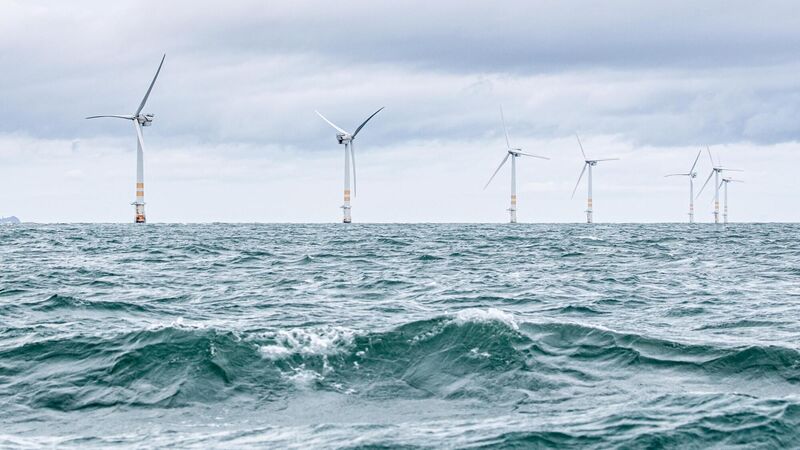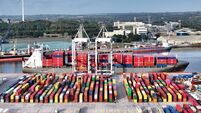Turbulent year for offshore developers casts shadow on future projects in Ireland

Ireland's first and only operational offshore wind farm at the Arklow Bank Wind Park (Phase 1), off the coast of Arklow, Co. Wicklow. Constructed in 2003/04, the seven wind turbines have a capacity of 25.2 MW and they are owned and operated by GE Energy. By Neil Michael (16.11.21)
A turbulent year so far for offshore wind has cast a shadow on the outlook for the industry, especially as major players withdraw their interest in developments.
The most recent event that rocked the industry in Ireland was Europe's largest producer of renewable energy, Statkraft’s announcement that it is pulling out of offshore projects and refocusing on onshore renewables.
“This year has not been without its challenges,” said Steph Unsworth, senior associate and Ireland product manager at Aurora Energy Research.
In the three months to the end of June, Statkraft’s net loss jumped to 6.5 billion Norwegian crowns, around €555,400, compared to from 992 million crowns in the same period a year earlier, forcing the utility giant to regroup on its strategy going forward.
Ireland’s offshore targets will be impacted greatly by Statkraft’s decision as the company announced it will not bid in State’s upcoming Offshore Renewable Energy Support Scheme (ORESS).
Consequently, the future of the deisgnated Tonn Nua site off the south-east coast is in jeopardy as it requires developers with significant financing power.
Months before Statkraft’s announcement, Irieland’s offshore wind targets experienced a significant setback. Developer Corio Generation pulled out of the €1.4bn Sceirde Rocks offshore windfarm project in Connemara, Co. Galway.
The windfarm was expected to generate clean energy for 350,000 homes and was part of six projects that secured Phase One State contracts through an auction process.
Ireland has committed to achieving 5GW of installed offshore wind capacity by 2030 and 37GW by 2050. This 2050 target represents approximately about six times the current peak electricity demand.
“While progress is steady and there is much to look forward to, the long lead times we’re seeing for the phase one projects, in respect to planning applications in particular, means it’s unlikely the 5GW by 2030 target will be achieved,” said Ms Unsworth.
VP for development and offshore at Statkraft Ireland Donal O’Sullivan has critised long wait times in the past and suggests they are a key reason for the sluggish progress in Ireland’s offshore wind sector.
“Projects that submitted tens of thousands of pages of planning applications with over three to four years of survey information early last year, are still being asked to submit more information which means it will be middle of next year before this information can be provided and likely to be another 12 months before An Coimisiún Pleanála makes planning decisions on the first round of projects,” he explained.
“In all, it now looks like the planning process is likely to take at least three years for those projects' in the best case scenario, whereas there would have been an expectation that it would have been closer to 12 months of a process,” he added.
Ms Unsworth also noted the lack of approvals for submitted planning applications as being another stumbling block for offshore wind development, but overall she remains optimistic.
“The year began with the final phase one projects submitting their planning permission, and long awaited details of the Tonn Nua auction were released,” she said.
The Tonn Nua auction will be completed in November, with provisional results expected 27 November.
“There’s also an ongoing Public Consultation on National Territory Mapping for Renewable Electricity which aims to outline additional maritime areas for future offshore wind deployment, a very encouraging sign for long-term deployment,” said Ms Unsworth.
However, Ireland is not alone when it comes to setbacks in the offshore sector, as developers worldwide navigate policy changes in key markets, supply chain bottlenecks and rising costs.
“I think at the global level offshore wind deployment has been much slower than what alot of experts believed it would be. Ireland is no different from alot of countries where is it already understood that 2030 targets for offshore will be missed,” said Mr O’Sullivan.
Unlike some other countries, Ireland continues to run ORESS auctions for Government-backed contracts for difference (CfDs), in an effort to support offshore wind sector.
“In terms of nuts and bolts of delivery of the first phase of offshore projects which won ORESS contracts in 2023, the failures in the Irish planning system have been highlighted,” said Mr O’Sullivan.
On European-wide scale, the weighted average cost of capital for offshore wind projects has risen by approximately three to four percentage points from 2020 to 2024, accroding to a report by one of the world’s largest renewable energy developers, Ørsted.
Higher interest rates account for a 1.5-2.5 percentage point increase, following aggressive monetary policy decisions by the European Central Bank (ECB) in response to soaring inflation. Interest rates have since steadily decreased but these declines will not immediately be felt by offshore developers.
“It is easy to think of the current impasse as a problem mainly for the private sector. However, if not properly addressed, including at political and regulatory levels, all of society will lose out,” said Rasmus Errboe, Ørsted chief executive.

In many European markets lower retail electricity prices and reduced incentives following the energy crisis have made residential projects less economically attractive, according to the International Energy Agency (IEA).
Furthermore, supply chain challenges and higher costs have left multiple offshore wind auctions without bids, leading to several project cancellations and a 24% downwards forecast revision compared with last year, the IEA said.
Meanwhile, an economic development agency InterTradeIreland commissioned a report earlier this year which found strong potential to develop a globally competitive offshore wind supply chain if efforts are aligned across the island.
Newry-based InterTradeIreland is funded by the Department of Enterprise, Tourism and Employment in the Republic and the Department for the Economy in the north of Ireland.
The report, published earlier this year, highlighted the need for further investment in infrastructure to support the development of offshore wind. The recent Budget did allocate significant funding to build a stronger grid with increased capacity but a pressing issue for offshore developers remains port access.
The only port with the infrastructure to support large scale offshore wind on the island is located in Belfast, however, Cork harbour has made progress in this area.
Central to the port infrastructure deficit is the challenge of raising the funds required for development, which is typically more than €/£100m per port.
Funding for port redevelopment for offshore wind build out is challenging due to several factors including the misalignment of the investment timelines for offshore wind projects and port upgrades, the uncertainty surrounding the realisable port revenue stemming from uncertainty about the location and timing of offshore wind development, according to the report.
The report from specialist renewables consultancy Everoze, published in May, mapped over 160 companies across 12 supply chain sectors.
“This is the first time that SME capability in the renewable energy sector has been mapped across the island,” said Margaret Hearty, InterTradeIreland’s chief executive.
“There is a real opportunity for indigenous SMEs to enter the supply chain, which can be fully realised by working together on an all-island level,” she added.














